Lost civilizations capture the imagination of explorers and scholars. Atlantis and Lemuria have fascinated people for centuries. Some think they are just myths, while others believe they might be true.
Stories and geological clues suggest there might be some truth to these tales. People are drawn to the idea of forgotten cultures and mysterious societies. They hope to uncover secrets of an underwater world that history forgot.
Plato’s story of Atlantis sparked new questions about sunken lands. The tales of Lemuria also raise interesting questions. These stories might give us a glimpse into the lives of ancient civilizations facing sudden changes.
Many wonder if these legends mix fiction and fact. They hint at a lost golden age, hidden by natural and cultural disasters.
Key Takeaways
- Atlantis and Lemuria spark debates about history and myth.
- Legends hint at real events hidden beneath the sea.
- Sunken realms stir interest in ancient mysteries worldwide.
- Forgotten cultures enrich our knowledge of the past.
- Archaeological wonders keep curiosity alive today.
- Mysterious societies prompt us to question known history.
Unraveling the Myths of Atlantis
Stories of Atlantis are among the most famous historical enigmas. Plato first talked about this grand place in Timaeus and Critias. He said it was a powerful rival to Athens. The story of its sinking has captured people’s imaginations for ages.

Atlantis is seen as a mythical city because of its supposed greatness. Scholars think it’s a story about the dangers of being too proud. They believe it warns us about societies that grow too fast.
Origins and Plato’s Description
Plato described Atlantis as a place full of advanced culture and strong navies. He used it as a lesson about the dangers of pride and power.
Archaeological Wonders and Speculations
Researchers keep looking for proof of Atlantis’s existence. They think volcanic eruptions might have sunk it, like the ones that hit the Minoans. Others believe it might be linked to the Sea Peoples, but there’s no solid proof yet.
Public Fascination Over the Centuries
Many theories have made people curious about Atlantis. Stories of lost civilizations and advanced technology keep the debate alive. People search through old tales, hoping to find out if Atlantis was real.
- Central theme of moral decline
- Connection to real-world catastrophes
- Inspiration for modern fiction
| Theory | Key Idea |
|---|---|
| Minoan Eruption | Massive volcanic event leading to widespread devastation |
| Platonic Allegory | Symbolic lesson on the pride of powerful nations |
Lemuria and Other Mysterious Societies
Lemuria started as a scientific idea in the 1800s. It was meant to explain how animals could travel far. But, modern geology pushed it aside. Yet, its story in ancient history lived on.
People like Helena Blavatsky and W. Scott-Elliot made Lemuria a mystical tale. They said it was home to an advanced, wise race. This idea caught the interest of many spiritual groups.
Stories of lost cities often tie back to Lemuria. They talk about places with deep wisdom and knowledge. Places like Mu or Kumari Kandam are also part of these tales.
People look for historical ruins to find proof of these stories. They believe these places might hold secrets of the past.
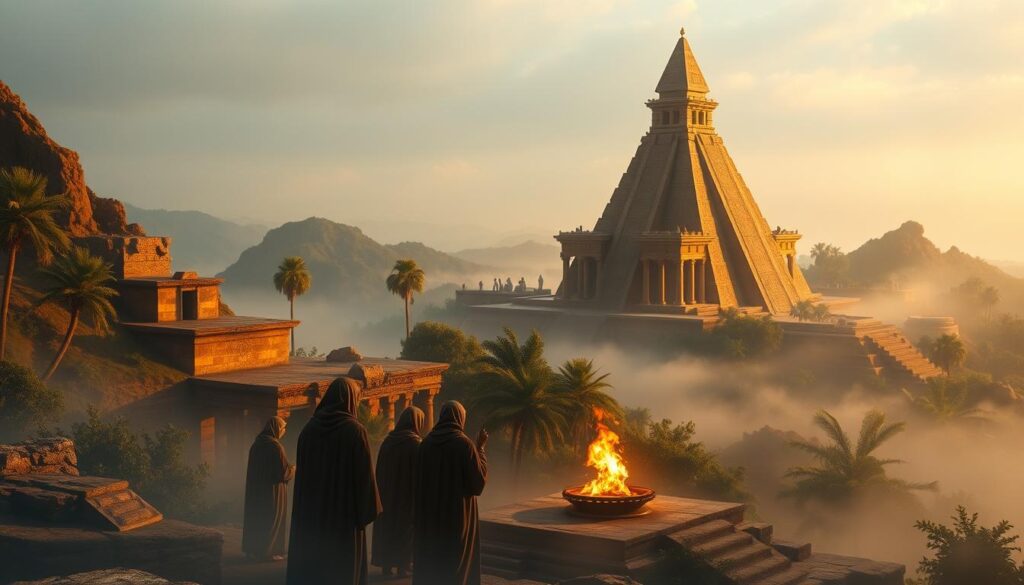
Old stories often mention prehistoric cultures that thrived. These tales drive civilization exploration. They make us look closer at old texts and artifacts.
Some stories say these lands vanished in disasters. This leaves us wondering about their connection to megalithic structures around the world.
Scientists try to separate fact from myth. They look at the earth’s history to understand these stories. Lemuria shows how a single idea can spark a lot of curiosity and research.
How Ancient Mysteries Shape Modern Curiosity
People love stories that push the limits of what we know. Ancient tales make us want to uncover hidden truths. They spark our imagination, making us wonder about lost cultures.
Some think megalithic structures hold secrets of secret origins and advanced knowledge.

Influence on Modern Culture
Big-budget movies often show atlantis as a place full of amazing technologies. Fans look for signs of mythical lost civilizations, even though these stories are not always supported by science. The mystery of lost civilizations keeps experts and hobbyists curious.
Writers and filmmakers mix fact, folklore, and fiction in their work. Museums show exhibits on lost ancient civilizations, sparking debate. This interest comes from a shared curiosity about what lies beneath the dust of centuries.
Role of Media in Preserving Legends
TV specials and viral videos make us think about global mysteries. Some say there’s a coverup, while others remind us that evidence is limited. Media creates excitement around rumored discoveries, keeping the public interested in legendary places.
Films, podcasts, and talk shows keep these legends alive. They share new theories and stories, keeping them in our cultural conversation. They tap into our timeless desire to find what’s hidden beneath the waves or beyond familiar places.
Tracing the Legends: From Mu to Shambhala
The idea of hidden lands is more than just stories. It captures the hearts of many. Mu is said to be a vast land in the Pacific, home to advanced societies. Shambhala, from Tibetan lore, is a paradise of wisdom.
People read every book they can find on lost civilizations. They hope to learn something new. Some even go on quests to find these lost places, following every lead they can find.
Stories of places like Atlantis talk about amazing buildings and knowledge. Scholars think Mu and Shambhala show our deep desire for growth. Every new find keeps the dream alive, pushing explorers to keep searching.
Many believe lost civilizations shaped our past. Debates are ongoing, but evidence shows these tales are important. They remind us of our endless creativity.
Universities worldwide study ancient texts and earth signs for clues. They look for hints of these hidden lands. This search often makes us rethink what we know about early cultures.
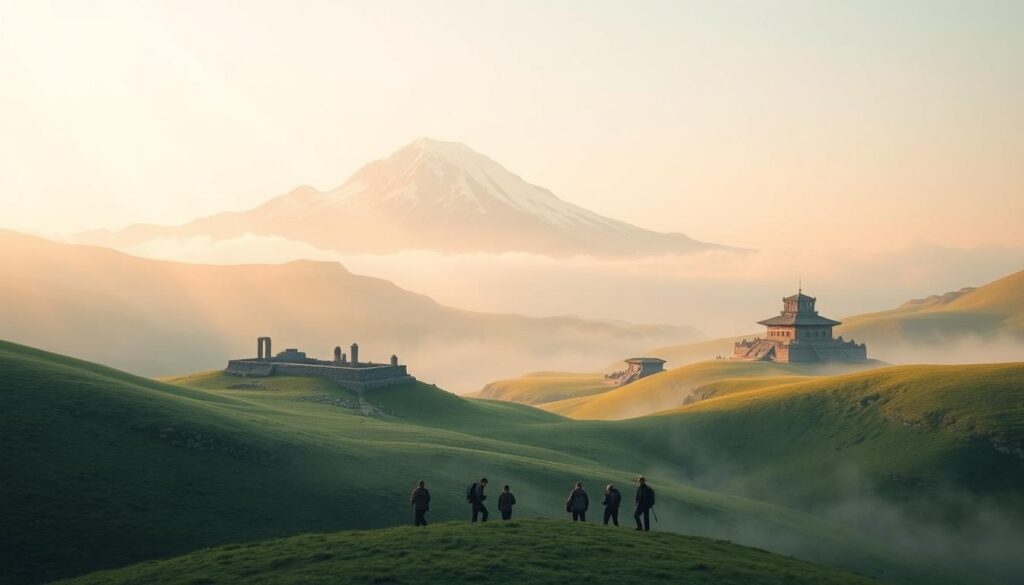
Significant Archaeological Discoveries That Fuel the Debate
Historic ruins and new artifacts keep the mystery alive for those who love ancient lost civilizations. Places like Minoan structures on Crete or the grand temples of the Maya have sparked many stories. Some believe these sites connect to more mysterious ideas, mixing legends with truth.
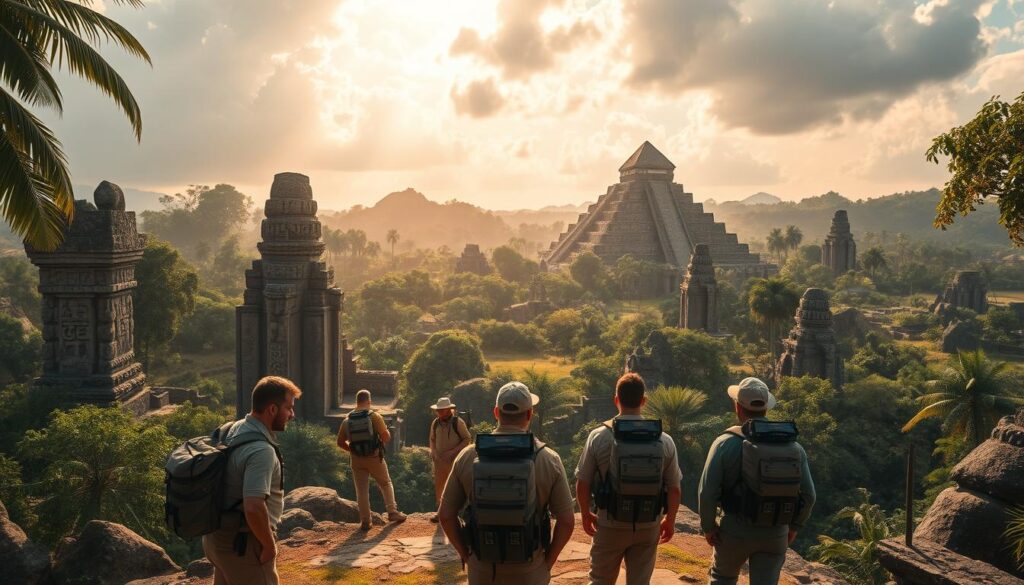
Unearthing Forgotten Cultures
Archaeologists work hard to find clues from different places that might show us lost civilizations in the amazon or elsewhere. They find hints of big cities that make us wonder about the knowledge of societies that disappeared. This search makes us think about ancient lost technology and opens up new possibilities.
Recent Breakthroughs Around the Globe
Using remote sensing in dense jungles, we’ve found signs of lost amazon civilizations that lived in amazing ways. Satellite images show possible buildings that suggest big settlements. Stories of sunken cities like Dwarka in India also expand our view, making us think about human progress and innovation.
These finds show us that the line between fact and myth is not always clear. As we keep digging, we might learn more about the secrets of the past.
Science keeps growing as experts find more about early human achievements. In Crete, we see advanced drainage systems that were unknown before. In Central America, the Maya’s big pyramids show us humanity’s drive for greatness.
With graphic reconstructions and laser mapping, we see buried cities in a new light. These tools help us understand civilizations that were once thought to be myths. Every new temple or underwater road we find shows the complexity of past cultures. Scholars think there’s more to discover, making us wonder about the secrets hidden in sand or rainforests.
Forgotten Cultures: Beyond the Popular Myths
Legends of Atlantis or Lemuria are huge. Yet, places like Tiwanaku, near Lake Titicaca, get less attention. The Babylonians and Aztecs shaped history, but their stories often get lost in myths.
Exploring lost civilizations reveals real architectural wonders. These ruins show the grandeur of once-thriving kingdoms. Their stories teach us more than myths.
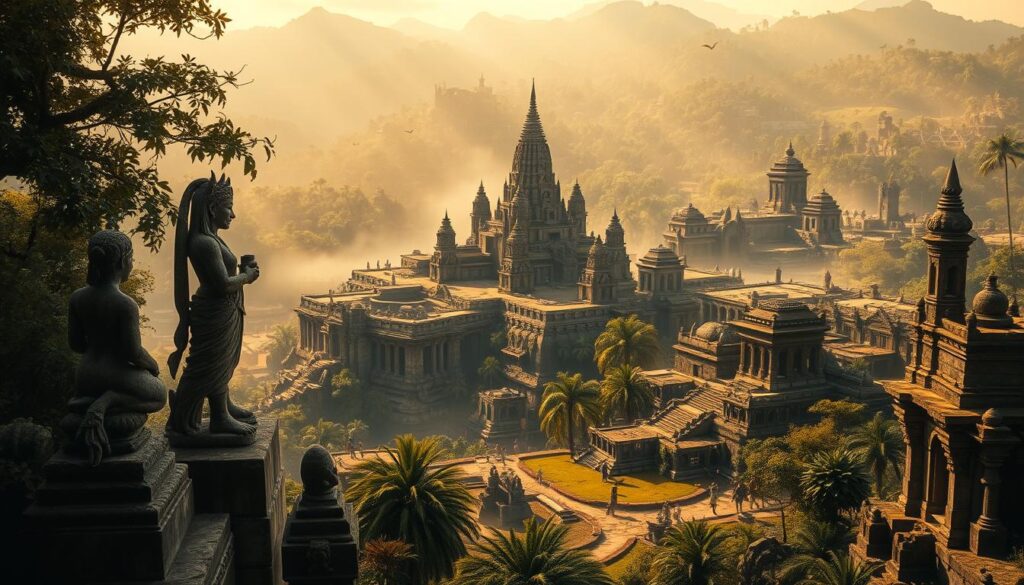
The lost civilizations of south america were known for their engineering skills. The Inca empire built temples that still challenge modern builders. Their structures in mountains show advanced techniques.
Examining lost native american civilizations shows diverse cultures. Expedition records reveal trade, alliances, and daily life. Each society left a unique mark on history.
Some study lost civilizations of north america through torrents. Explorers watch documentaries to learn about them. The Khmer Empire and Indus Valley show real achievements that go beyond myths.
People buy lost civilizations dvd to learn more. These societies combined astronomy, engineering, and art. Their work sparks ongoing research today.
Tiwanaku’s stonework still puzzles experts. The Babylonians built massive ziggurats and advanced math. The Aztecs left cities filled with vibrant art.
Each civilization left a lasting impact. Their achievements deserve study and respect. This ensures their contributions are remembered among ancient legends.
Expedition Chronicles: Yearning for History’s Hidden Cities
History whispers about hidden realms. Many seek out secret ruins, driven by a thirst for knowledge. Fresh discoveries spark imaginations and prompt new views of the past.
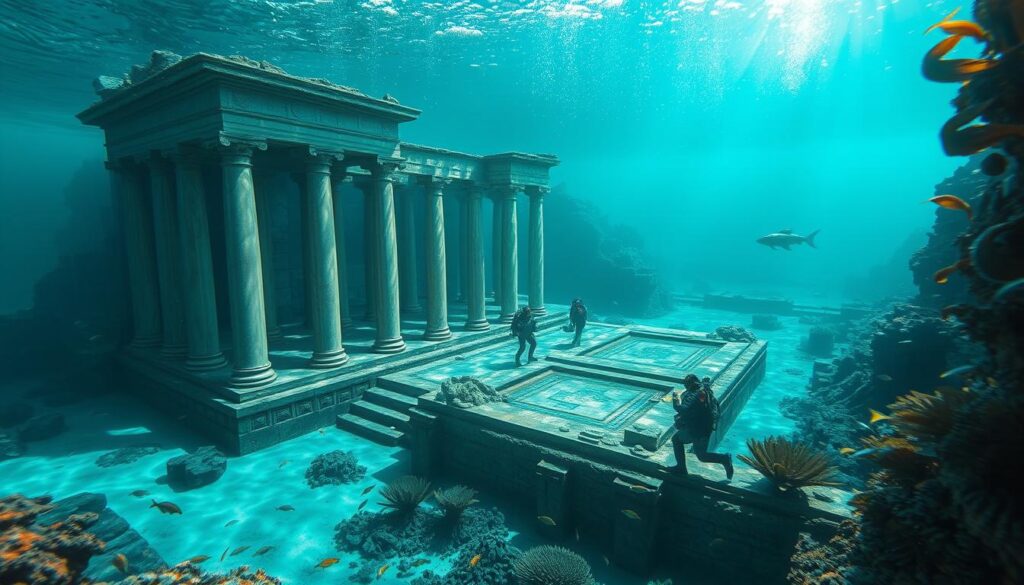
Adventurous Journeys into Ancient Ruins
Bold expeditions have led explorers to hidden places. They’ve found labyrinthine tunnels in Greece, sunken temples near Asia, and massive cliff dwellings across the Americas. Documentaries on major networks, like National Geographic, showcase these daring quests.
Readers often grab books lost civilizations greece download or watch a lost civilizations tv series before planning their own trips. These experiences bring ancient myths to life. They inspire a deeper respect for human achievements.
The Role of Exploration in Understanding the Past
Venturing beyond well-known sites reveals how communities thrived in remote lands. Teams dive into potential underwater lost civilizations, hoping to uncover remains of cities drowned by shifting oceans. This passion fuels a growing lost civilizations book series and engages fans of lost civilizations dvd.com who hunt for clues.
Movie enthusiasts flock to theaters for the latest lost civilizations movies. They seek captivating theories on vanished worlds. By gathering artifacts and surveying ruins, explorers piece together an evolving timeline of lost societies.
Exploring the Concept of Lost Civilizations
Some societies leave a lasting mark on history but fade away over time. Their remains spark curiosity and create legends. Each tale offers a glimpse into achievements and mysteries that challenge our view of the past.
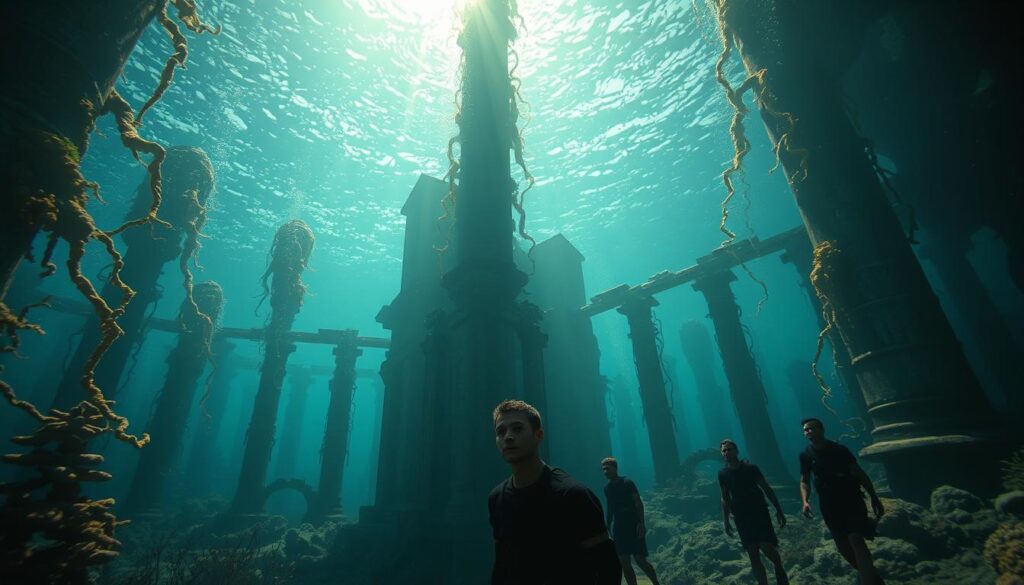
Plato’s civilization is a classic example, often seen as the start of epic stories. Lost civilizations mentioned by plato spark debates about their disappearance. Some theories suggest they had engineering feats, inspiring ideas about lost civilizations with advanced technology that rival today’s inventions.
Defining the Term in Historical Context
A culture might fade away, leaving behind writings or continuous lineages. A truly lost civilization vanishes, leaving few clues. We wonder: Are there any lost civilizations that existed only in myth, or do they have real roots in archaeology? Exploring lost civilizations underwater sparks wonder about what once thrived beneath the waves.
Why These Vanished Societies Still Intrigue Us
People are drawn to any lost civilizations documentary that delves into vanished realms. Tales of hidden cities, heroic quests, and sudden downfall captivate us. Mesopotamia, featured in time life lost civilizations mesopotamia collections, offers a glimpse into humanity’s first empires. Yet, the gap between known facts and mysteries keeps us fascinated.
Humans are driven to understand societies that rose and fell before our time. These stories go beyond normal historical cycles. They make us hope that remnants of a bygone era lie hidden, ready to change our view of past achievements.
Even without direct heirs or written records, lost societies live on in our imagination. The gap in historical records sparks debates, making us believe that knowledge or inventions were lost to time. Every artifact we find deepens our curiosity.
Clues from Ancient Ruins and Megalithic Structures
Archaeologists find clues that point to lost civilizations. Megalithic wonders pop up in unexpected places. This challenges our ideas about ancient societies.
Some structures seem too advanced, sparking debates about their creators. Researchers find megaliths in remote corners, offering new insights into lost civilizations in Africa and beyond. The massive stone alignments suggest methods that defy modern assumptions.
Strange stories, like relics found in fridge, hint at lost civilizations. These tales may be exaggerated but spark curiosity. They drive us to examine how these grand sites were built.
Newly exposed monoliths inspire scientific inquiry. Stone circles or colossal blocks raise questions about their creators and purpose. They stand as silent witnesses to traditions that once flourished.
Undiscovered structures in Africa or Southeast Asia challenge long-held beliefs. They reinforce the feeling that lost civilizations hold secrets about prehistoric achievements.
Experts note feats beyond standard timelines. Giant blocks show skills our ancestors possessed. These discoveries spark debates about overlooked parts in human progress.
- Impressive stone alignments across continents
- Mysteries surrounding transportation of huge blocks
- Enduring questions about cultural exchange among distant groups
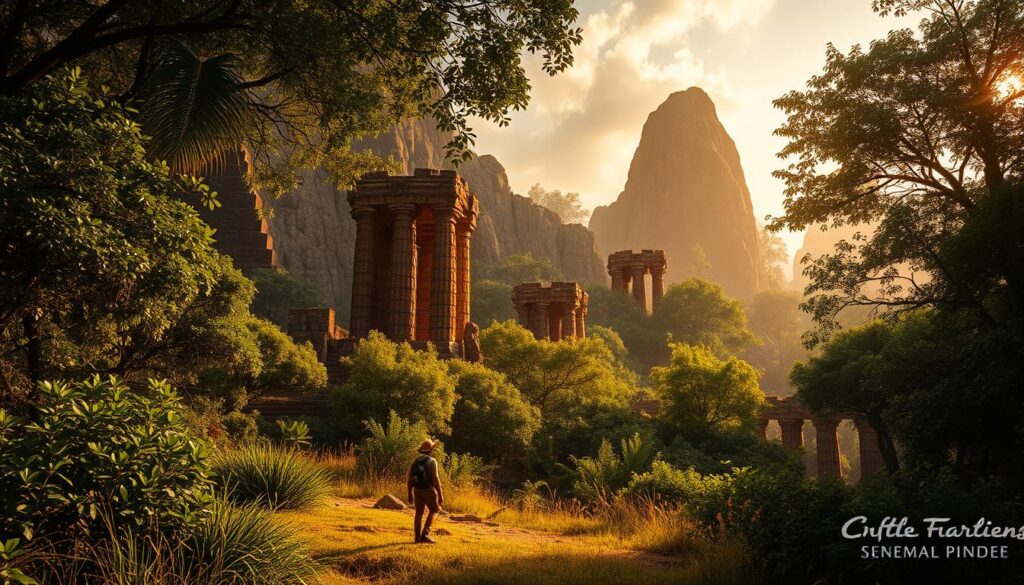
| Location | Notable Megalith | Approx. Age | Key Question |
|---|---|---|---|
| Africa | Stone Circles | Over 1,000 Years | Who erected them? |
| China | Massive Tombs | 2,000+ Years | Which techniques were used? |
| Southeast Asia | Giant Stone Jars | Unknown | Purpose for large jars? |
| Europe | Monolithic Temples | 4,000+ Years | Were they ceremonial? |
Cultural Links: Shared Patterns Among Vanished Societies
Documentaries on streaming services show interesting patterns in ancient creations. Mesoamerican pyramids share shapes with Asian designs, sparking debate on global exchange. Fans of lost civilizations netflix often find similar themes in sculptures and textiles.
Anthropologists are cautious but some wonder if advanced methods traveled across continents. Images of serpents, suns, and winged beings appear worldwide. This shared symbolism raises questions about cultural interaction.
Common Artistic Motifs Found Worldwide
In different regions, decorative paintings show symbols beyond local tales. Patterns from lost Mayan civilizations look similar to Mediterranean designs. This similarity leads some to consider these civilizations among the top lost ones, hinting at knowledge transfer.
Yet, scholars argue that people often respond in similar ways to common needs or spiritual ideas. A new documentary on Mesopotamia’s lost civilizations explores these connections. It shows evidence of parallel expressions in architecture and sculpture. Some turn to this resource for insights into cultural norms and privacy around global artifacts.
Architectural Parallels in Distant Lands
Archaeologists find striking similarities in temple layouts from Asia to the Andes. A narrative of lost temples and civilizations emerges, sparking speculation about global blueprints. Viewers wonder: could there be lost alien civilizations in our past?
Researchers suggest that large stone blocks and tiered platforms were practical responses to climate and geography. Still, explorers seek new evidence to confirm or challenge these ideas. Many are fascinated by the possibility of hidden timelines or global trade that shaped these sites.
Curious minds keep exploring these parallels in abandoned sites. Speculations abound, yet research continues, blending history and myth for fresh insights into humanity’s diverse heritage.
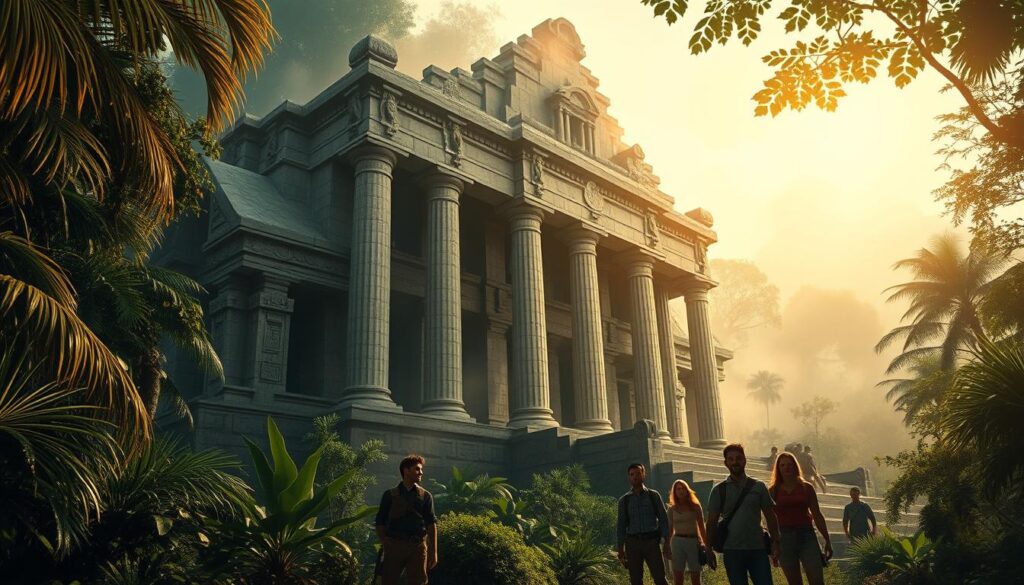
Controversial Theories: Aliens, Cover-Ups, and Hidden Timelines
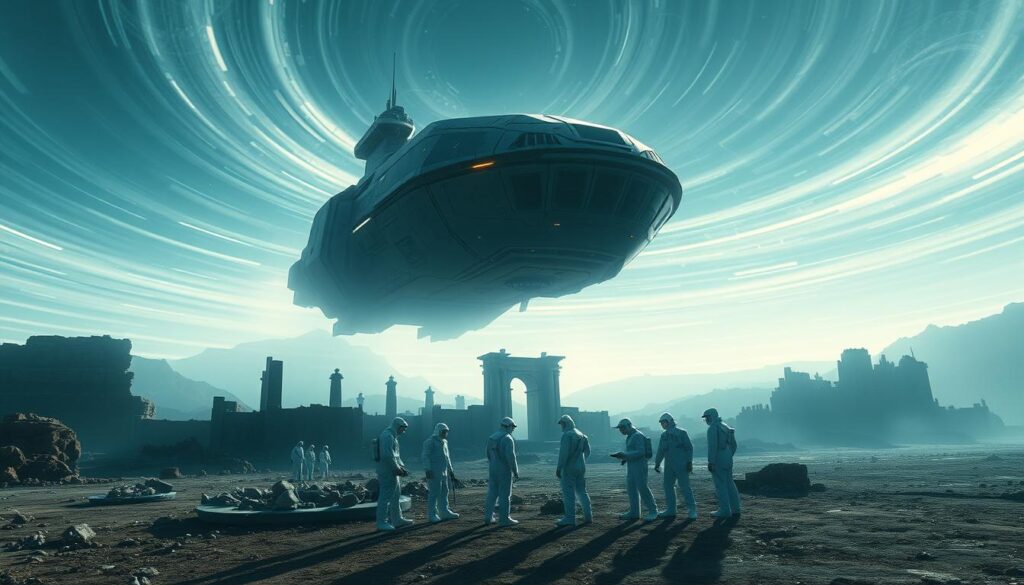
Some people think advanced aliens helped guide lost civilizations. They believe these aliens gave them knowledge that changed human history. Others think that some groups are hiding this information from us.
Shows on Netflix and other platforms share these ideas. They say aliens came to Earth and helped some groups leap forward in technology. Fans think that our history books might be missing important parts.
But, experts say we need solid proof for these claims. They say science doesn’t accept stories without evidence. Yet, some groups keep looking for clues, hoping to find the truth.
- Alien influences spark debates over human origins.
- Cover-ups suggest hidden archives in official vaults.
- Secret timelines challenge standard historical narratives.
Science voices warn us to be careful. It’s important to look at both sides of the story. People who are curious about aliens or secrets often talk online. They share stories of strange artifacts and mysterious texts.
Independent researchers see these ideas as a chance to discover something new. They look into old texts, hoping to find new meanings. The debate continues online, where people share their findings and wonder about the past.
| Theory | Claim | Main Barrier |
|---|---|---|
| Alien Intervention | ETs guided certain societies | Lack of conclusive proof |
| Institutional Cover-Ups | Authorities hide crucial data | Official denials, limited access |
| Hidden Timelines | History extends further back | Contradicts standard analyses |
Documentaries and Books: How Media Shapes Our Perception
Stories about lost ancient civilizations often reach us through streaming, cable specials, and books. Many people get excited when they hear about lost ice age civilizations or ancient ones before the ice age.
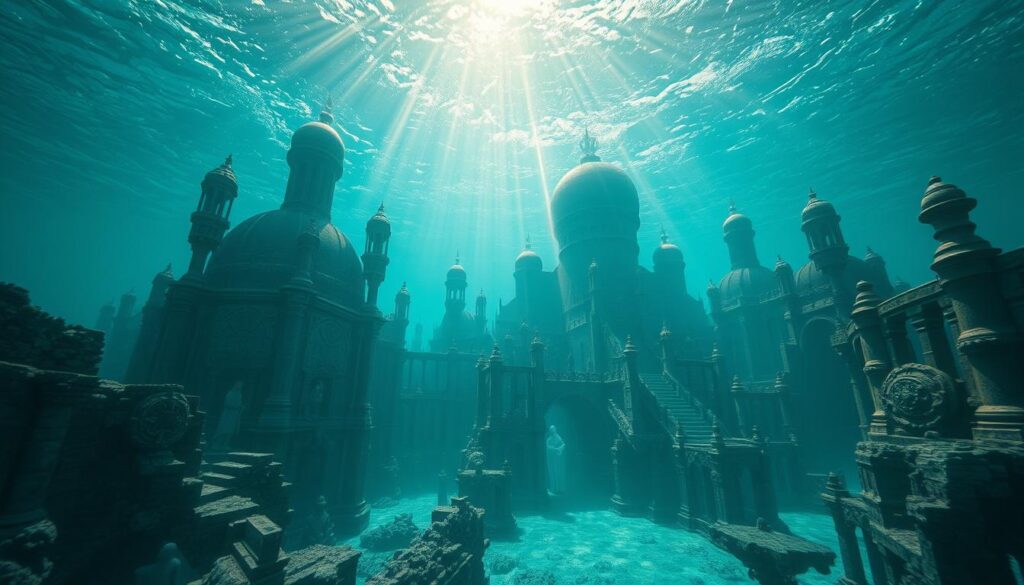
People watch shows that show off amazing buildings or mysterious artifacts. Some parts talk about lost ancient super civilizations. This sparks debates between experts and those who believe in different timelines.
The Rise of Lost Civilizations Documentaries
Channels like National Geographic and History Channel have made tv shows about lost civilizations. Each episode digs into new evidence, mixing legends, local tales, and archaeological findings. These shows lead to different theories, making fans curious and sparking discussions.
Fans keep a list of lost civilizations to follow new finds. This list helps them keep up with the latest discoveries.
Popular Authors and Their Theories
Authors like Graham Hancock suggest worlds before our known history. They propose that advanced societies left behind clues tied to lost civilizations before the ice age. Researchers believe that travelers shared knowledge across continents, showing innovations beyond our usual history.
Modern Research: Technological Advances in Civilizational Studies
Many wonder: are there lost civilizations waiting to be uncovered? Archaeologists and historians keep searching with new technology. Tools like LIDAR scans, genetic sequencing, and underwater robotics are changing how we see ancient communities.
These tools are shedding new light on places like the indus: lost civilizations or south america lost civilizations. As we learn more, our understanding of the past grows. This is because new methods often challenge old ideas.
National Geographic lost civilizations reports show how these advances change our view of the past. Scholars say that data is always being updated or changed. This reflects new ideas in the field.
Public interest is growing, thanks to documentaries and podcasts. Lost civilizations joe rogan episodes share bold theories. These spark debates about our forgotten origins.
Digital platforms are making it easier for people to get involved. Fans of age of empires lost civilizations see connections between games and history. Online discussions are lively, connecting fans with experts.
People are looking at new details, comparing artifacts, and exploring new areas. For more insights, visit this resource with innovative research and updates.
Experts are now open to new ideas. Some evidence suggests early cultures had complex cities earlier than thought. Others think these groups might have influenced global maritime routes.
Yet, new discoveries keep challenging these theories. This calls for more open-minded exploration.
Academic circles are no longer quick to dismiss new leads. They look at unusual artifacts, use satellite data, and apply machine learning. This collaboration is leading to new insights across fields.
It shows how much we still don’t know about our shared history.
Recent methods include:
- Expeditions charting submerged ruins
- Genetic profiles identifying migratory links
- Advanced imaging revealing hidden structures
These methods are helping us understand forgotten societies better. Each new finding adds to our wonder and sparks more conversation.
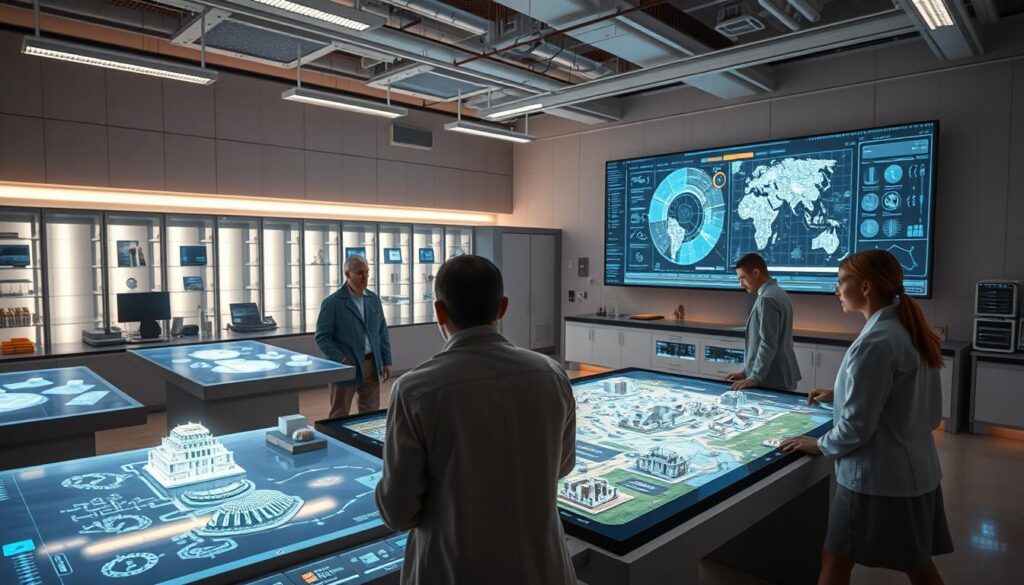
Debunking Myths vs. Preserving Wonder
Stories of sunken kingdoms excite and make us question. Scholars tell us to look at each story with a critical eye. They remind us to use evidence to guide us.
People love the mystery of lost civilizations like Atlantis. They find inspiration in the unknown. This mix of doubt and wonder shapes how we see new ideas.
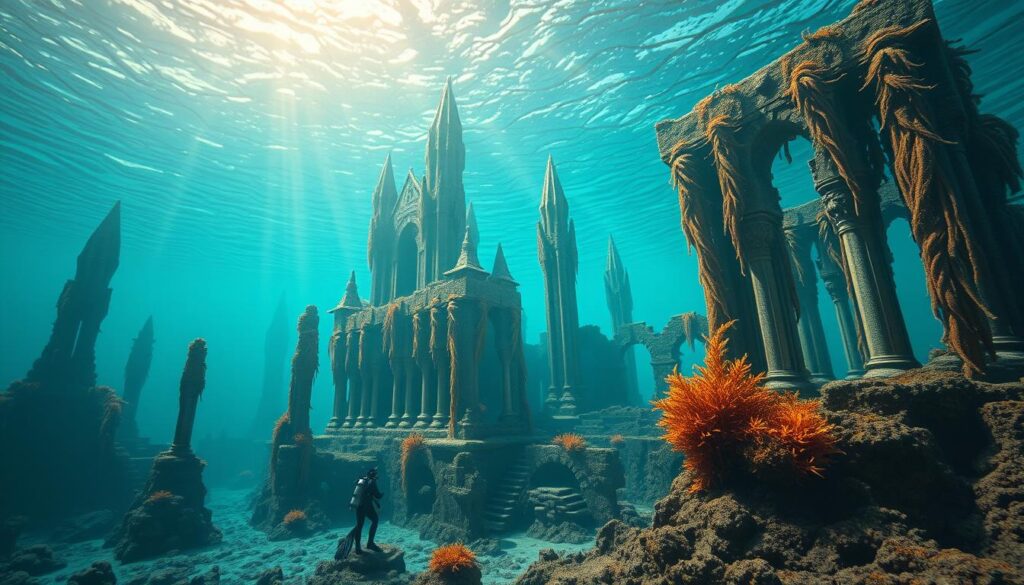
Some researchers find connections between cultures across the world. They look at history from different places, like Africa and Asia. They warn us not to let exciting stories hide real discoveries.
It’s important to find a balance between believing and doubting. This balance helps us learn more about the past. It keeps our curiosity alive.
Striking the Balance Between Fact and Fiction
Real data should be the foundation of our beliefs. Stories of lost civilizations in Asia teach us to separate myth from fact. By carefully examining these stories, we can find clues and keep our imagination alive.
Academics focus on what we can prove. But they also keep an open mind for new discoveries. This way, we can have respectful discussions.
The Cultural Value of Mystery
Wonder drives us to explore and learn. It inspires young people to study lost civilizations or visit old ruins. Myths bring people together by sharing common dreams.
Our love for hidden empires strengthens our cultural bonds. It encourages us to dig deeper and uncover more about our history.
Conclusion
Every new find changes what we think is real and what’s just myth. Places like Atlantis and Lemuria are more than just stories. They show our deep desire to know where we come from and who we are.
These stories tell of advanced skills and warn us of dangers. They make us think about our own world and future.
Today, science and technology help us uncover these lost worlds. Tools like radar and satellite maps are used to find clues. Genetic studies also play a big role in understanding our past.
But the mystery of these lost places still captivates us. People love to explore these stories because they spark our curiosity. They make us want to learn more about our history.
The search for these lost civilizations continues. It’s driven by new ideas and stories in the media. Everyone hopes that the next big find will reveal secrets of the past.

